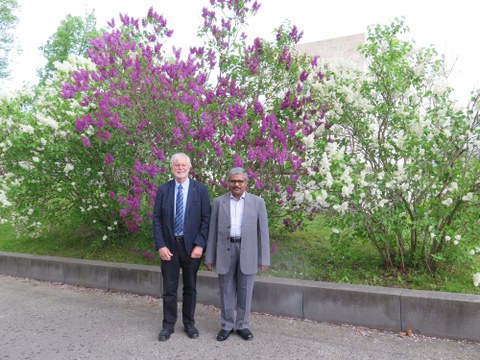May 04, 2018
Investigating mechanisms of nanoplasticity

For almost 15 years, guest researcher Prof. Suwas (right) and Prof. Skrotzki from TU Dresden have been researching and exchanging in the field of solid state and materials physics.
AvH Bessel awardee from India researching on high strength - high ductility nanocrystalline materials at TU Dresden
The phenomena of nanoplasticity is the research focus of internationally renowned scientist Prof. Dr. Satyam Suwas, a guest at TU Dresden since April. When the grain size of polycrystalline materials decreases, their strength increases. This effect is turned around though when it comes to grain sizes beneath about 20 nanometres. Most commonly, the processes that lead to grain refinement also drastically decrease the ductility, that is the material’s ability of being plastically deformed before rupture. To achieve maximum strength without loosing much ductility, the mechanisms of nanoplasticity have to be understood. This problem is what Prof. Suwas from the Indian Institute of Science is working on in the course of the Friedrich Wilhelm Bessel Research Award, given by the Alexander von Humboldt Foundation. The award is to appreciate and promote Prof. Suwas’s outstanding achievements in the fields of severe plastic deformation and texture development of materials, where he contributed towards the fundamental understanding of deformation mechanisms and the correlation of textures with properties. During his research stay of seven months at TU Dresden, Prof. Suwas is hosted by the Chair of Metal Physics, Prof. Dr. Werner Skrotzki at the Institute of Solid State and Materials Physics.
”Prof. Skrotzki and I have been researching in the same fields and exchanging ideas for almost 15 years. In 2003, we published our first paper together”, Prof. Suwas explains his connection to the Dresden Professor for Metal Physics. “Ever since my stay in France between 2002 and 2004, we have continuously been interacting, discussing and making substantial progress in this field. We know what to do and how to proceed.” The professors are now intensifying this long-standing cooperation in Dresden until October – afterwards they will continue to work on the research problem at their respective institutes, Prof. Skrotzki at the Technische Universität, and Prof. Suwas at the Indian Institute of Science in Bangalore, where he is heading the Laboratory for Texture and Related Studies. This collaboration not only brings the scientific locations of Dresden (Germany) and Bangalore (India) closer, but also amalgamates the fundamental understanding and applications. “If we are able to influence the properties of materials, like strength and ductility, in the right way, many applications can be foreseen. For example, it would enable easy forming of difficult to shape materials like titanium alloys”. The physicists are primarily researching on the fundamental nature of nanocrystalline materials, while the engineering scientists are looking into their applications. “The fundamental understanding that we are exploring here has found a good combination with the application oriented research of Prof. Suwas”, Prof. Skrotzki says happily.
Media inquiries:
Prof. Dr. Werner Skrotzki
Tel.: +49 (0) 351 463-35144
